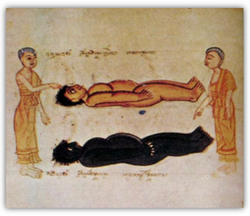Philosophy:Maraṇasati
Maraṇasati (mindfulness of death, death awareness) is a Buddhist meditation practice of remembering (frequently keeping in mind) that death can strike at anytime (AN 6.20), and we should practice assiduously appamada and with urgency in every moment, even in the time it takes to draw one breath. Not being diligent every moment, is called negligence by the Buddha (AN 6.19). In the Earliest discourses of the Buddha, the term Maranasati is only explicitly defined twice, in those two suttas AN 6.19 and AN 6.20.
Later Buddhist schools have expanded the meaning of maranasati to include various visualization and contemplation techniques to meditate on the nature of death. The cultivation of Maranassati is said to be conducive to right effort and also helps in developing a sense of spiritual urgency (Saṃvega) and renunciation (Nekkhamma).[1]
Theravada Buddhism
Mindfulness of death is a common practice in Southeast Asian Buddhist monasteries.[1] Buddhist monasteries such as Wat Pah Nanachat will often have human skeletons on display in the meditation hall.[2]
In the Pali Canon
9 cemetery contemplations are not Maraṇa-sati
In Pali Canon, cemetery contemplations are classified under body immersed mindfulness (kaya-gata-sati), not Maranasati (mindfulness of death). Cemetery contemplations can be used to inspire urgency in practice and continuous maranasati, but they are not properly classified under maranasati, as many Buddhists assume, nor is general philosophical inquiry into the nature of death. Perhaps Later schools of Buddhism have redefined maranasati in this way.[citation needed]
The Satipatthana Sutta (MN: 10) and the Kayagata-sati Sutta (MN: 119) include sections on the cemetery contemplations which focus on nine stages of corpse decomposition (Pali: nava sīvathikā-manasikāra). These are:
- A corpse that is "swollen, blue and festering."
- A corpse that is "being eaten by crows, hawks, vultures, dogs, jackals or by different kinds of worms."
- A corpse that is "reduced to a skeleton together with (some) flesh and blood held in by the tendons."
- A corpse that is "reduced to a blood-besmeared skeleton without flesh but held in by the tendons."
- A corpse that is "reduced to a skeleton held in by the tendons but without flesh and not besmeared with blood."
- A corpse that is "reduced to bones gone loose, scattered in all directions."
- A corpse that is "reduced to bones, white in color like a conch."
- A corpse that is "reduced to bones more than a year old, heaped together."
- A corpse that is "reduced to bones gone rotten and become dust." [3]
The Satipatthana Sutta instructs the meditator to reflect thus: 'This body of mine, too, is of the same nature as that body, is going to be like that body, and has not got past the condition of becoming like that body.'

According to the Maranassati Sutta (2) a monk should reflect on the many possibilities which could bring death and then turn his thoughts to the unskillful mental qualities he has yet to abandon. "Just as when a person whose turban or head was on fire would put forth extra desire, effort, diligence, endeavor, undivided mindfulness, & alertness to put out the fire on his turban or head, in the same way the monk should put forth extra desire, effort, diligence, endeavor, undivided mindfulness, & alertness for the abandoning of those very same evil, unskillful qualities." [5]
In Arahant Upatissa's Vimutti-magga
Vimutti-magga predates Buddhaghosa's Visuddhimagga by several hundred years, and Buddhaghosa used it as the basis for Visuddhimagga. Vimutti-magga, from the introductory paragraph, clearly is in complete agreement with Pali Canon discourses on the definition of maranasati.
Q. What is mindfulness of death? What is the practising of it? What are its salient characteristic, function and near cause? What are its benefits? What is the procedure?
A. The cutting off of the life-faculty — this is called death. The undisturbed mindfulness of this — this is called the practicing of it. The cutting off of one's life is its salient characteristic. Disagreeableness is its function. Well-being is its near cause.
What are its benefits ?
He who practises mindfulness of death is possessed of diligence as regards the higher meritorious states, and of dislike as regards the demeritorious.
In Buddhaghosa's Visuddhimagga
According to Buddhaghosa's Visuddhimagga, there are eight ways of meditating on death:
meditating on death as a murderer, since it takes away life; meditating on it as the ruin of success; viewing it by comparison with famous persons reflecting that even these great ones eventually died, even the enlightened ones themselves; meditating on the body as the abode of many-many worms as well as the target of many others; meditating on the difficulty of keeping alive; meditating on it as without occasion, since beings die unpredictably; meditating on the shortness of a lifetime; meditating on the fact that, properly speaking, the lifetime of a being is a single moment of consciousness, that one dies every moment, so to speak.[6]
Tibetan Buddhism

Mindfulness of death is a central teaching of Tibetan Buddhism: it is one of the "Four Thoughts," which turn the mind towards spiritual practice. One set of Tibetan Buddhist contemplations on death come from the eleventh century Buddhist scholar Atisha.[7] Atisha is said to have said to his students that if a person is unaware of death, their meditation will have little power.[8]
Atisha's contemplations on death:
- Death is inevitable.
- Our life span is decreasing continuously.
- Death will come, whether or not we are prepared for it.
- Human life expectancy is uncertain.
- There are many causes of death.
- The human body is fragile and vulnerable.
- At the time of death, our material resources are not of use to us.
- Our loved ones cannot keep us from death.
- Our own body cannot help us at the time of our death.
Other Tibetan Buddhist practices deal directly with the moment of death, preparing the meditator for entering and navigating the Bardo, the intermediate stage between life and death. This is the theme of the popular Great Liberation through hearing during the intermediate state (Tibetan Book of the Dead).
See also
- Memento mori
- Right Effort
- Viriya
References
- ↑ 1.0 1.1 Rosenberg, Larry. The Supreme Meditation, Shambala Sun, http://www.shambhalasun.com/index.php?option=content&task=view&id=1792
- ↑ Ajahn Jagaro, Death and Dying, http://www.katinkahesselink.net/tibet/death_jagaro.html
- ↑ The Way of Mindfulness The Satipatthana Sutta and Its Commentary by Soma Thera, http://www.accesstoinsight.org/lib/authors/soma/wayof.html#discourse
- ↑ from Teaching Dhamma by pictures: Explanation of a Siamese Traditional Buddhist Manuscript
- ↑ AN 6.20 Maranassati Sutta: Mindfulness of Death (2) translated from the Pali by Thanissaro Bhikkhu http://www.accesstoinsight.org/tipitaka/an/an06/an06.020.than.html
- ↑ Potter, Karl H (1970). "The Encyclopedia of Indian Philosophies Vol. IX Buddhist Philosophy From 350 to 650 AD," p. 124.
- ↑ Joan Halifax Roshi, The Nine Contemplations of Atisha. http://www.upaya.org/roshi/dox/Contemplations.pdf
- ↑ Powers, John. Introduction to Tibetan Buddhism, Ch. 10


